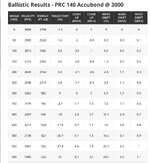West2East
FNG
New-ish long range shooter here. I recently bought a Tikka 6.5CM for my wife  and I've been doing a LOT more shooting as a result. For this discussion, assume shooting out to 800yds and hunting out to 500yds.
and I've been doing a LOT more shooting as a result. For this discussion, assume shooting out to 800yds and hunting out to 500yds.
I live basically at sea level and I try to get shooting at elevation every once in a while. After reading several threads, watching THLR videos and getting out and shooting myself, I'm starting to question how much things like temperature, Elevation, pressure, etc. affect the trajectory of a bullet.
On here, I have learned to start compiling all of this into a DA number using a simple DA chart, with a "close" temperature and the elevation off of ONX. I plug that into Strelok and get my MOA adjustment. Strelok allows you to have a DA input, which has been nice.
My original data from my usual(sight-in) and my original velocity truing @474 yds was done at a DA of 1250. The actual elevation is somewhere around 480ft.
Last week I was Shooting at a DA of 3500 with the actual elevation being about 3300ft. I found that the difference in elevation adjustment between the 2 areas was about 1/4 MOA. This was out to 800yds.
When I got back, I started making up quick cards for a few different DA's that I figured I may have during Hunting season and I noticed that unless you have swings of almost 3000-5000DA. The actual DOPE adjustments aren't very significant and may actually get lost in the noise of field position shooting. It almost seems like I could get by with 1 maybe 2 cards for the spectrum of DAs that I'll have while hunting.
First of all, am I doing something wrong? Second, how can this be true and then you get articles or comments implying that it is highly important that you take your shooting environmentals into consideration? Which when you factor those into a DA, it really doesn't seem to matter unless you were in an area with Wild swings of DA.
Thanks for any info that can be provided. I know DA is being talked about quite a bit in other threads but I didn't want to clutter up one of them with this question.
I live basically at sea level and I try to get shooting at elevation every once in a while. After reading several threads, watching THLR videos and getting out and shooting myself, I'm starting to question how much things like temperature, Elevation, pressure, etc. affect the trajectory of a bullet.
On here, I have learned to start compiling all of this into a DA number using a simple DA chart, with a "close" temperature and the elevation off of ONX. I plug that into Strelok and get my MOA adjustment. Strelok allows you to have a DA input, which has been nice.
My original data from my usual(sight-in) and my original velocity truing @474 yds was done at a DA of 1250. The actual elevation is somewhere around 480ft.
Last week I was Shooting at a DA of 3500 with the actual elevation being about 3300ft. I found that the difference in elevation adjustment between the 2 areas was about 1/4 MOA. This was out to 800yds.
When I got back, I started making up quick cards for a few different DA's that I figured I may have during Hunting season and I noticed that unless you have swings of almost 3000-5000DA. The actual DOPE adjustments aren't very significant and may actually get lost in the noise of field position shooting. It almost seems like I could get by with 1 maybe 2 cards for the spectrum of DAs that I'll have while hunting.
First of all, am I doing something wrong? Second, how can this be true and then you get articles or comments implying that it is highly important that you take your shooting environmentals into consideration? Which when you factor those into a DA, it really doesn't seem to matter unless you were in an area with Wild swings of DA.
Thanks for any info that can be provided. I know DA is being talked about quite a bit in other threads but I didn't want to clutter up one of them with this question.

